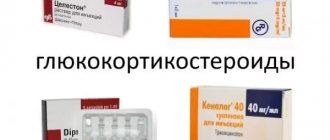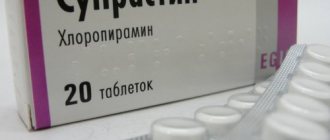Dosage forms and composition of Tramadol
The active component of the drug is Tramadol hydrochloride. This substance is an opioid agonist and acts on specific receptors in the central nervous system, inhibiting sensitivity to pain. Tramadol is considered an analgesic of mixed action. Available in several forms for local and systemic use:
- Tablets: white coated, scored, in dosages of 50, 100 mg. Packed in blisters, packaged in 10–100 pieces. Excipients in the composition: starch, silicon dioxide, magnesium stearate, MCC.
- Gelatin capsules: 50 mg each, yellowish in color, contain white powder inside the shell.
- Suspension for oral administration: clear sweetish liquid with mint and anise aroma, 1 ml - 100 mg of active ingredient, water, propylene glycol, glycerin, sucrose, flavorings, essential oils. Available in glass bottles
- Solution for injection: with a dosage of 50 mg Tramadol hydrochloride per 1 ml. Water-based, in glass ampoules 1–5 ml.
- Rectal suppositories: fat-based, white torpedo-shaped, packaged in cell blisters. Each suppository contains 100 mg of active substance.
Tramadol Retard tablets are also available with a dosage of up to 200 mg, which have a longer lasting effect.
Tramadol
Tramadol is used as prescribed by a doctor; the dosage regimen of the drug is selected individually depending on the severity of the pain syndrome and the sensitivity of the patient. The duration of treatment is determined individually; the drug should not be prescribed beyond the period justified from a therapeutic point of view.
Tramadol is intended for intravenous (administer slowly), intramuscular, or subcutaneous administration. Unless otherwise prescribed, Tramadol should be prescribed in the following dosages.
For adults and teenagers over 14 years old
for a single administration of 50-100 mg of tramadol hydrochloride (1-2 ml of solution for injection). If satisfactory analgesia does not occur, a repeat single dose of 50 mg (1 ml) may be prescribed after 30-60 minutes. For severe pain, a higher dose (100 mg tramadol hydrochloride) may be prescribed as an initial dose. In general, 400 mg of tramadol hydrochloride/day is usually sufficient to relieve pain.
For the treatment of pain due to cancer and severe pain in the postoperative period
Higher doses may be used.
Children over 1 year of age
injection solution can be prescribed in a single dose at the rate of 1-2 mg/kg of the child’s body weight. A daily dose of 4-8 mg/kg body weight is usually sufficient. Tramadol is diluted with water for injection. Dilute Tramadol with water to obtain final concentration.
| 1 ml of the drug contains 50 mg of tramadol | |
| Tramadol+water | Concentration |
| 1 ml + 1 ml | 25.0 mg/ml |
| 1 ml + 2 ml | 16.7 mg/ml |
| 1 ml + 3 ml | 12.5 mg/ml |
| 1 ml + 4 ml | 10.0 mg/ml |
| 1 ml + 5 ml | 8.3 mg/ml |
| 1 ml + 6 ml | 7.1 mg/ml |
| 1 ml + 7 ml | 6.3 mg/ml |
| 1 ml + 8 ml | 5.8 mg/ml |
| 1 ml + 9 ml | 5.0 mg/ml |
| 2 ml of the drug contains 100 mg of tramadol | |
| Tramadol+water | Concentration |
| 2 ml + 2 ml | 25.0 mg/ml |
| 2 ml + 4 ml | 16.7 mg/ml |
| 2 ml + 6 ml | 12.5 mg/ml |
| 2 ml + 8 ml | 10.0 mg/ml |
| 2 ml + 10 ml | 7.1 mg/ml |
| 2 ml + 14 ml | 6.3 mg/ml |
| 2 ml + 16 ml | 5.8 mg/ml |
| 2 ml + 18 ml | 5.0 mg/ml |
Example:
To administer a dose of 1.5 mg of tramadol hydrochloride per kg of body weight to a child weighing 45 kg, 67.5 mg of tramadol hydrochloride is required. To do this, 2 ml of Tramadol is diluted with 4 ml of water for injection to a final concentration of 16.7 mg of tramadol hydrochloride per milliliter. Then 4 ml of the diluted solution is administered (total dose is approximately 67 mg of tramadol hydrochloride).
It is possible to dilute injection solutions with solutions for infusion for intravenous administration. In this case, 0.9% sodium chloride solution or 5% glucose solution is used for dilution.
In elderly patients
(aged 75 years or more) due to the possibility of delayed elimination, the interval between administrations of the drug can be increased in accordance with individual characteristics.
In patients with kidney and liver diseases
Tramadol may last longer. For such patients, the doctor may recommend increasing the interval between single doses.
Tramadol should not be prescribed for longer than therapeutically necessary.
How does Tramadol work?
The active substance of the drug, penetrating into the blood, binds to opioid receptors of various types in the brain and spinal cord. As a result, the production of pain neurotransmitters is reduced and the conductivity of neurons is inhibited. The intensity of painful sensations decreases, among other things, due to the effect of Tramadol on the receptors of the digestive tract.
- The drug inhibits the functioning of both cerebral hemispheres;
- has a calming effect;
- inhibits the cough reflex;
- affects the respiratory center.
The effect of use develops after 15–20 minutes and lasts up to 6 hours, depending on the intensity of the pain syndrome. The most effective dosage form is an injection solution. With prolonged use, the analgesic effect of Tramadol decreases, and the body requires a greater concentration of it.
The drug is metabolized in the liver tissues, part of it is excreted unchanged by the kidneys. The half-life of Tramadol can last up to 2 days or more in case of cholecystitis, hepatitis, hepatosis and other liver pathologies. The effect of the drug on the body continues.
Tramadol solution for injection 50 mg/ml 2 ml ampoules 5 pcs. in Moscow
Tramadol solution for injection 50 mg/ml is intended for intravenous jet, intramuscular, subcutaneous and intravenous drip administration. Intravenous administration of the solution for injection is carried out in a slow stream or drip after dilution in the solution for injection.
The doses used depend on the severity of the pain syndrome and the individual sensitivity of the patient. It is necessary to select the minimum effective dose of the drug. When treating chronic pain syndrome, you should adhere to a specific schedule of drug administration.
Adults and teenagers over 12 years old
A single dose for a single administration is 50 - 100 mg of tramadol (1-2 ml of solution for injection). If satisfactory analgesia has not occurred 30-60 minutes after the first administration, 50 mg (1 ml) of tramadol can be re-prescribed.
For severe pain, 100 mg of tramadol is recommended as an initial dose. Depending on the intensity of the pain syndrome, the analgesic effect of tramadol lasts 4-8 hours. In the postoperative period, short-term use of tramadol in doses exceeding those indicated is possible. The maximum daily dose of tramadol should not exceed 400 mg, with the exception of certain clinical cases (for example, in the treatment of pain in cancer patients and in the postoperative period).
Children aged 1 to 12 years
Tramadol in the form of an injection solution is prescribed in a single dose at the rate of 1 - 2 mg/kg of the child’s body weight. It is necessary to select the minimum effective dose.
The total daily dose of tramadol should not exceed 8 mg/kg of the child’s body weight or no more than 400 mg per day, the calculation is based on the lowest value.
Elderly patients
In elderly patients (up to 75 years) who do not have clinically significant hepatic or renal failure, dose adjustment is usually not required. In patients over 75 years of age, elimination of the drug may be slower. Therefore, if necessary, increase the interval in prescribing the drug in accordance with the characteristics of the patient.
Patients with renal failure or on dialysis and patients with liver failure
If renal and/or liver function is impaired, the elimination of tramadol from the body is slowed down. If necessary, the interval between doses of the drug should be increased.
Calculation of the volume of solution for injection:
To calculate the total dose of tramadol (mg), you need: body weight (kg) x dose (mg/kg).
The volume (ml) of the diluted solution to be administered is calculated as follows: divide the total dose (mg) by the appropriate concentration of the diluted solution (mg/ml; see table below).
| Tramadol 50 mg (50 mg/ml - 1 ml) injection solution + added diluent | Tramadol 100 mg (50 mg/mg - 2 ml) injection solution + added diluent | Concentration of diluted injection solution (mg tramadol/ml) |
| 1 ml + 1 ml | 2 ml + 2 ml | 25.0 mg/ml |
| 1 ml + 2 ml | 2 ml + 4 ml | 16.7 mg/ml |
| 1 ml + 3 ml | 2 ml + 6 ml | 12.5 mg/ml |
| 1 ml + 4 ml | 2 ml + 8 ml | 10.0 mg/ml |
| 1 ml + 5 ml | 2 ml + 10 ml | 8.3 mg/ml |
| 1 ml + 6 ml | 2 ml + 12 ml | 7.1 mg/ml |
| 1 ml + 7 ml | 2 ml + 14 ml | 6.3 mg/ml |
| 1 ml + 8 ml | 2 ml + 16 ml | 5.6 mg/ml |
| 1 ml + 9 ml | 2 ml + 18 ml | 5.0 mg/ml |
In accordance with the calculation, dilute the contents of the ampoule by adding a solvent, mix and enter the calculated volume of the finished solution. Discard any unused injection solution.
Duration of therapy
Tramadol should under no circumstances be used for longer than necessary. With long-term use of tramadol, depending on the intensity or etiology of the pain syndrome, periodic monitoring is necessary (if necessary, with breaks in taking the drug) to determine the need for further therapy and optimize the dosage regimen.
When is Tramadol indicated?
The drug is used to reduce and eliminate pain of various origins:
- for physical injuries: dislocations, fractures, soft tissue ruptures, severe burns;
- consequences of surgical interventions;
- when performing invasive painful diagnostic procedures;
- in the later stages of malignant oncological tumors;
- after myocardial infarction;
- with neurological manifestations.
Injection forms of the drug, tablets, capsules and suppositories are approved for adults and children over 14 years of age. Tramadol drops can be used in patients from 1 year of age.
In what cases is Tramadol prohibited?
The use of analgesics in all forms is excluded in case of individual intolerance to the active and auxiliary substances, alcohol abuse or poisoning, or dependence on psychoactive substances. Other contraindications:
- suicidal tendencies, severe clinical depression;
- renal and liver failure;
- undergoing treatment with certain psychotropic drugs;
- epilepsy that cannot be corrected with medications;
- first trimester of pregnancy.
In late pregnancy and lactation, Tramadol is prescribed in exceptional cases for individual indications.
Side effects of Tramadol
While using the medication, dizziness, general lethargy, increased drowsiness, decreased appetite and nausea are possible. In rare cases, and after overdoses, the following develop:
- impaired coordination of movements;
- tachycardia;
- visual or auditory hallucinations;
- respiratory depression;
- vomiting, diarrhea;
- abdominal cramps;
- skin itching.
In case of intoxication with the drug, the following are possible: urinary retention, confusion or loss of consciousness, vascular collapse, convulsions. In women, long-term use may cause menstrual irregularities. It is typical that prolonged use of the drug leads to drug dependence.
How to use Tramadol: instructions
The drug is prescribed by a doctor in short courses as a symptomatic remedy. The regimen of use and dosage depend on the physical condition and age of the patients.
- Instructions for oral solution: patients over 14 years old - 20 drops with a spoon of sugar or water, 1 time per day. If necessary, it is allowed to repeat the dose after 1–2 hours. Children under 14 years of age: at the rate of 1 mg. per 1 kg. body weight.
- Tablets and capsules are taken with water, before or after meals. Daily dose: 50 mg. For severe pain, an increase to 400 mg is possible.
- Tramadol injections are given subcutaneously, intravenously or intramuscularly. Before administration, the contents of the ampoules are diluted in saline solution. Daily doses of the drug vary from 50 to 400 mg. Time intervals between injections: 4–6 hours.
- Suppositories are used rectally, introducing 1 piece. from 1 to 4 times a day.
Elderly people suffering from reduced liver or kidney function are recommended to reduce the dose of Tramadol by half.
Tramadol, 50 mg/ml, solution for injection, 2 ml, 5 pcs.
Tablets:
orally,
with a small amount of liquid. The drug is used as prescribed by a doctor, the dosage regimen is selected individually, depending on the severity of the pain syndrome and the sensitivity of the patient. The duration of treatment is determined individually; the drug should not be prescribed beyond the period justified from a therapeutic point of view.
In the absence of other prescriptions, the drug should be prescribed in the following dosages: orally for a single use in adults and children over 14 years of age - 50 mg, after 30-60 minutes the same dose can be repeated, but not more than 8 doses per day. The maximum daily dose is 400 mg.
Elderly people (75 years and older) and patients with renal failure require individual dosage. When creatinine Cl is less than 30 ml/min and in patients with liver failure, a 12-hour interval is required between taking subsequent doses of the drug.
Solution for injection:
intravenously
(injected slowly, no more than 1 ml of solution per minute, which corresponds to 50 mg of tramadol),
intramuscularly, subcutaneously
. To dilute the drug, you can use water for injection, saline solution and 5% dextrose solution.
Dilution of the drug Tramadol with water to obtain the final concentration is shown in the table.
Table
| Drug volume, ml | Volume of water for injection, ml | Resulting concentration, mg/ml |
| 1 or 2 | 1 or 2 | 25 |
| 1 or 2 | 2 or 4 | 16,7 |
| 1 or 2 | 3 or 6 | 12,5 |
| 1 or 2 | 4 or 8 | 10 |
| 1 or 2 | 5 or 10 | 8,3 |
| 1 or 2 | 6 or 12 | 7,1 |
| 1 or 2 | 7 or 14 | 6,3 |
| 1 or 2 | 8 or 16 | 5,6 |
| 1 or 2 | 9 or 18 | 5 |
The doses recommended below are indicative. In practice, it is necessary to select the minimum analgesically effective dose. The duration of treatment with the drug is determined individually. Do not use longer than is justified from a therapeutic point of view.
Adults and teenagers over 14 years of age:
single dose - 50-100 mg, repeated administration of the drug after 4-6 hours is possible. Maximum daily dose - 400 mg.
Children from 1 to 14 years old:
single dose 1-2 mg/kg, maximum daily dose - 8 mg/kg.
Patients with impaired renal and/or liver function.
In patients in these categories, it is difficult to remove tramadol from the body. In the case of the treatment of acute pain syndromes in such patients, when a rare or single dose of tramadol is necessary, no special dosage changes are required. However, in the case of treatment of chronic pain, it is necessary to remember the danger of accumulation of the drug in the body, therefore it is advisable to increase the intervals between its individual doses. The drug should be prescribed with caution to patients with impaired renal function (50–100 mg 2 times a day), as well as to persons with cirrhosis of the liver (in this group of patients, T1/2 of tramadol increases almost 3 times).
Elderly patients.
In elderly patients (over 75 years of age), the elimination of tramadol from the body slows down, even when there are no clinical manifestations of impaired renal and/or liver function. In these patients, it is also necessary to increase the intervals between individual doses of the drug. It is recommended not to exceed the daily dose of 300 mg.









